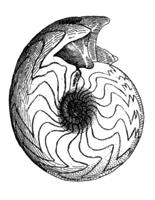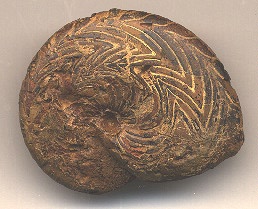| Goniatites are an extinct group of ancient marine animals
which evolved from the nautiloids during the early in the Devonian period
some 400 million years ago. They became extinct during the Permian period. |
.
|
| The goniatites are classified as ammonoids, which is
an extinct group. The ammonoids are part of a larger group, cephalopods,
which includes belemnites and nautiloids. The cephalopods are part
of a larger group of animals called the molluscs, which includes bivalves
and gastropods. |
|
 |
 |
The goniatites all possessed an external shell, which
is divided internally into chambers. The animal lived in the largest
external chambers and the internal chambers would have been filled with
gas making the animal buoyant in the water. The general structure of the
goniatites would have been similar to that of their relatives the ammonites,
being a free swimming animal possessing a head with two well developed
eyes and tentacles. To learn more about ammonites, along with belemnites
and nautiloids, just click on the appropriate icon below.
Goniatites are small to medium in size often less than 15 centimeters
in diameter (6 inches).The shell is always coiled, unlike that of the later
ammonites of the Mesozoic era who, some of which evolved into partially
coiled or completely uncoiled forms. The shape of most goniatite shells
suggests that they were poor swimmers.
The thin walls between the internal chambers of the shell are called
the septa, and as the goniatite grew it would move its body forward in
the shell secreting septa behind it, thereby adding new chambers to the
shell. The sutures are visible as a series of narrow wavy lines on
the surface of the shell. The sutures appear where each septa contacts
the wall of the outer shell. |

|
| A distinctive feature of the goniatites is the “zigzag”
pattern of their sutures. The sutures of nautiloids are, by comparison,
somewhat simpler; being either straight, or slightly curved. A goniatite
displaying characteristic “zigzag” sutures is shown here.
Goniatites are found in North America, Europe, North Africa and Australia.
Certain limestones in western part of the Republic of Ireland are packed
with beautifully preserved goniatite fossils. They are also found
in marine bands of the Carboniferous
Coal Measures in Europe and in marine rocks of the Pennsylvanian
period in Arkansas. Large numbers of goniatites occur in rocks from the
Devonian period of Morocco, and they are important zone ,or index fossils,
used by geologist in dating the rocks of that period. To learn
more about geology, just click on the icon below. |

|




